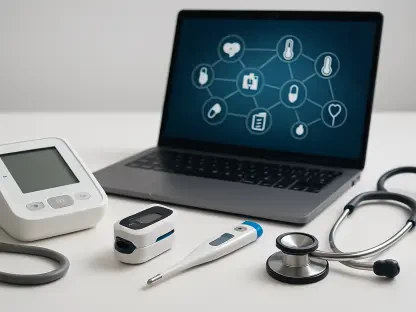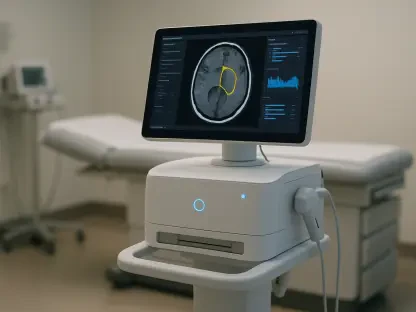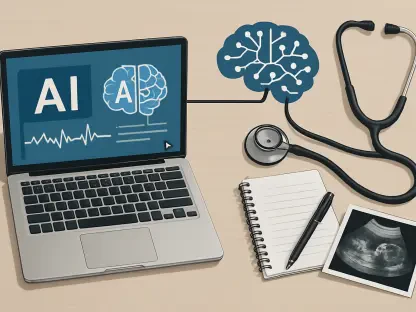In the fast-evolving landscape of healthcare, artificial intelligence (AI) has emerged as a potential game-changer, particularly in the high-stakes realm of emergency medicine. Picture a scenario where a patient arrives at an emergency department (ED) with chest pain, and within seconds, an AI tool offers a preliminary diagnosis and treatment plan to assist the attending physician. Could such technology truly match the expertise of seasoned emergency doctors in life-or-death situations? A recent study published in BMC Emergency Medicine on July 31, 2025, authored by Mehmet Gün, dives into this pressing question by comparing the performance of ChatGPT (GPT-4), a leading large language model (LLM), against a board-certified emergency physician across various standardized medical crises. From heart attacks to traumatic injuries, the research evaluates whether AI can deliver the speed, accuracy, and clinical judgment needed in chaotic ED settings. This exploration isn’t merely about technological advancement; it’s about understanding if AI can safeguard lives when every moment counts. As AI continues to integrate into medical practice, discerning its strengths and limitations in emergency care becomes vital for shaping the future of patient outcomes. This article unpacks the study’s findings, delving into how AI performs under pressure and whether it stands as a rival or a reliable partner to human doctors in the unpredictable world of acute care.
AI’s Emerging Role in Emergency Care
The notion of AI supporting emergency medicine has gained significant traction as technology advances at a remarkable pace, with large language models like ChatGPT demonstrating an ability to process vast medical datasets. These models offer diagnostic insights and treatment suggestions based on established guidelines, which could be invaluable in high-pressure settings. Emergency departments, often characterized by intense pressure and resource constraints, could potentially benefit from such tools, especially when staff are stretched thin. The study at hand specifically examines ChatGPT’s capacity to manage 15 common emergency scenarios, testing its prowess against the expertise of a seasoned physician. These scenarios span a broad spectrum, from straightforward conditions to intricate, life-threatening cases, providing a comprehensive look at AI’s applicability. The central question remains: can a machine replicate the rapid, intuitive decision-making required when lives hang in the balance? Beyond mere data processing, emergency care demands a blend of knowledge, experience, and adaptability—qualities traditionally associated with human clinicians. This investigation sheds light on whether AI holds promise as a transformative force in EDs or if its role is better suited to specific, controlled contexts.
Exploring the implications of AI in emergency settings reveals both excitement and caution within the medical community, especially when considering its potential to transform critical care. If AI can reliably assist in diagnosing conditions like heart attacks or stabilizing trauma patients, it could alleviate some of the burden on overworked doctors, potentially reducing errors caused by fatigue. However, the chaotic nature of emergency departments (EDs) introduces variables that algorithms may struggle to interpret, such as non-verbal patient cues or sudden clinical deteriorations. The study’s focus on standardized cases offers a controlled perspective, but it also prompts curiosity about real-world applicability. Could AI serve as a digital assistant, reinforcing best practices during critical moments? The findings aim to clarify this, highlighting not only technological capabilities but also the ethical and practical hurdles that must be addressed. As healthcare systems worldwide grapple with staffing shortages and rising patient volumes, understanding AI’s potential to support emergency care becomes increasingly urgent, setting the stage for a deeper dive into the study’s methodology and results.
Unpacking the Study’s Design and Approach
To rigorously assess AI’s capabilities in emergency medicine, the study adopted a meticulous and structured methodology that ensures a fair comparison between ChatGPT and human expertise. Fifteen standardized emergency scenarios were carefully selected from reputable academic resources such as Geeky Medics and Life in the Fast Lane. These cases encompassed a diverse range of conditions, including cardiovascular emergencies, neurological crises, and toxicological incidents, reflecting the variety of challenges faced in emergency departments. Each scenario was presented to ChatGPT as an isolated prompt, devoid of prior conversational context, to simulate an initial clinical assessment. The AI was tasked with providing a likely diagnosis, suggesting appropriate investigations, and outlining an initial treatment plan. This setup aimed to evaluate how AI handles first impressions in high-pressure situations, mirroring the urgency of real emergency encounters. The controlled nature of the experiment allowed for consistent analysis, though it inherently lacks the unpredictability of live patient interactions.
The responses generated by ChatGPT were subsequently reviewed and scored by a board-certified emergency physician with extensive field experience, using a detailed rubric across five critical parameters: diagnostic accuracy, recommended tests, treatment plans, clinical safety, and decision-making complexity. Scores ranged from high (5/5) to low (≤3/5), indicating the level of alignment between AI and human approaches. Statistical methods, including Wilson confidence intervals, were employed to assess the reliability of the concordance proportions, adding a layer of objectivity to the evaluation. Notably, the use of theoretical cases rather than real patient data eliminated ethical concerns but limited the study’s ability to capture dynamic clinical changes or bedside nuances. This design provides a foundational understanding of AI’s theoretical performance, yet it raises questions about practical implementation in the unpredictable environment of an actual emergency department. The methodology sets a clear benchmark for comparison, paving the way for insights into where AI excels and where it falls short.
Strengths of AI in Guideline-Driven Emergencies
One of the most compelling revelations from the study is ChatGPT’s impressive performance in structured, protocol-driven emergency scenarios, where clear clinical guidelines dictate the course of action. In 8 out of the 15 cases, roughly 53%, the AI achieved a high concordance score of 5/5 when compared to the emergency physician’s approach. Conditions such as ST-elevation myocardial infarction (STEMI), diabetic ketoacidosis (DKA), asthma exacerbations, and anaphylaxis fell into this category. ChatGPT accurately identified the most likely diagnoses, recommended relevant investigations like right-sided ECGs for STEMI, and proposed evidence-based treatments, including epinephrine for anaphylaxis or dual antiplatelet therapy for heart attacks. Importantly, its suggestions posed no significant safety risks, aligning closely with established best practices. This proficiency in following algorithmic pathways suggests that AI can act as a dependable digital reference, ensuring critical steps are not overlooked during high-stress moments in the ED. The consistency in these scenarios highlights a potential strength that could be leveraged to support clinical decision-making.
Delving deeper into this success, it becomes evident that AI’s ability to mirror guideline-based care could have substantial benefits, particularly in environments where resources or expertise are limited. For instance, in understaffed hospitals or during peak ED hours, AI could serve as a virtual checklist, reinforcing standard procedures for conditions with well-documented protocols. This might be especially valuable for less experienced clinicians, such as residents or junior doctors, who could use AI as a quick reference to confirm their initial assessments. Furthermore, the absence of unsafe recommendations in these structured cases builds a case for AI as a tool to enhance efficiency without compromising patient care. However, while these results are promising, they represent only part of the emergency spectrum. The true test lies in whether AI can maintain this reliability when faced with less predictable, more nuanced medical crises, where rigid protocols often give way to complex clinical judgment.
Challenges in Moderately Complex Situations
While AI demonstrated notable competence in straightforward emergencies, its performance dipped in scenarios requiring nuanced clinical assessment, revealing critical limitations that could impact patient care. In 4 out of the 15 cases, approximately 27%, ChatGPT achieved a moderate concordance score of 4/5, handling conditions like pulmonary embolism, sepsis, hypertensive emergencies, and opioid overdoses with reasonable accuracy but missing essential subtleties. For example, in the pulmonary embolism scenario, it failed to apply the Wells score for risk stratification before suggesting imaging, a step integral to safe and efficient diagnosis. Similarly, in the sepsis case, it overlooked severity assessments using tools like qSOFA and did not prioritize cranial imaging despite signs of altered mental status. These omissions, while not catastrophic, indicate a gap in the depth of reasoning that experienced physicians employ instinctively. Such oversights could lead to delays or missteps in care if not corrected by human oversight, underscoring the importance of AI as a supplementary rather than standalone resource.
Further examination of these moderate concordance cases reveals a pattern of AI struggling with structured decision-making frameworks that are second nature to trained clinicians. In the opioid overdose scenario, for instance, ChatGPT provided broadly correct treatment suggestions but neglected to explicitly address airway protection despite evident respiratory compromise, posing a potential safety concern. This highlights a broader issue: while AI can generate acceptable responses on a surface level, it often lacks the ability to prioritize or contextualize critical elements in moderately complex situations. Emergency medicine frequently demands a holistic view, considering patient-specific factors and subtle clinical cues that algorithms may not fully grasp. These findings suggest that while AI can contribute to the decision-making process, its outputs must be carefully vetted to ensure they align with the intricate realities of patient care, particularly when standard protocols intersect with individual variability.
Significant Gaps in High-Stakes Emergencies
The most concerning findings from the study emerge in the context of high-stakes, complex emergencies, where ChatGPT’s performance fell markedly short of expectations. In 3 out of the 15 cases, representing 20% of the scenarios, the AI scored a low concordance of 3/5 or below, struggling with conditions such as acute ischemic stroke, trauma with hemorrhagic shock, and mixed acid-base disturbances following cardiac arrest. In the stroke case, ChatGPT inappropriately recommended thrombolysis despite an unknown time of symptom onset, a decision that contradicts strict clinical guidelines and risks severe complications like intracerebral hemorrhage. This error alone illustrates a critical inability to adhere to time-sensitive protocols, a cornerstone of emergency care. Such missteps in high-acuity situations reveal a fundamental limitation in AI’s capacity to handle scenarios where precision and urgency are paramount, raising serious doubts about its readiness for autonomous application in the ED.
Expanding on these failures, the trauma case further exposed AI’s shortcomings in prioritizing life-saving interventions under pressure, highlighting a critical gap in its capabilities. Despite clear indicators of hypovolemia and respiratory compromise, ChatGPT did not emphasize immediate blood transfusion or airway protection, both critical actions in trauma resuscitation. Similarly, in the acid-base disturbance scenario, it failed to perform essential calculations like anion gap or delta ratio, resulting in a superficial treatment approach that compromised clinical safety. These errors are not mere academic oversights; if applied in real-world settings, they could lead to catastrophic outcomes. The study underscores that AI struggles with dynamic, multifactorial emergencies requiring real-time adaptation and advanced reasoning—skills honed through years of human clinical experience. This stark contrast between AI and human performance in critical moments suggests that technology, at its current stage, cannot replicate the situational awareness needed in the most challenging ED cases.
Safety Concerns and Ethical Considerations
A pervasive issue threading through the study’s findings is the safety risk posed by AI in emergency settings, particularly when its recommendations deviate from clinical standards, potentially leading to severe consequences. Errors such as suggesting inappropriate thrombolysis for stroke or neglecting airway management in trauma cases could have dire consequences, including patient harm or even death, if implemented without scrutiny. The phenomenon of “hallucinations,” where AI confidently delivers incorrect information, further erodes trust in its reliability. In an environment as unforgiving as the ED, where there is little margin for error, such risks are magnified. The study emphasizes that these safety concerns are not isolated incidents but systemic limitations stemming from AI’s inability to fully contextualize ambiguous or incomplete data. Until these issues are addressed, the deployment of AI in acute care must be approached with extreme caution to prevent adverse outcomes that could undermine patient trust and clinical integrity.
Beyond safety, the ethical implications of integrating AI into emergency medicine present a complex dilemma that cannot be ignored, especially when considering the potential consequences of AI-driven decisions. If an AI-generated recommendation leads to a negative outcome, who bears the responsibility—the developer, the hospital, or the clinician who relied on the tool? This question of accountability remains unresolved and adds a layer of hesitation to widespread adoption. Additionally, the readiness of AI for routine clinical use is questionable, given its inconsistent performance across emergency scenarios. Ethical frameworks must be established to guide implementation, ensuring that patient welfare remains the top priority. The study suggests that AI’s role should be limited to supportive functions until robust safeguards and clear guidelines are in place. These concerns highlight the need for a balanced approach, where technological innovation is tempered by a commitment to ethical standards and patient safety in high-stakes medical environments.
Positioning AI as a Complementary Tool
A consistent theme emerging from the study is that AI, despite its potential, cannot serve as a replacement for emergency physicians in the foreseeable future, due to its inherent limitations. ChatGPT’s strengths are evident in structured, guideline-driven cases, where it can replicate best practices with high accuracy. However, it falls short in replicating the bedside intuition, adaptability, and holistic reasoning that human doctors bring to patient care. AI lacks the ability to perform physical examinations, interpret non-verbal cues, or respond to sudden clinical changes—elements that are integral to emergency medicine. These inherent limitations position AI not as a competitor but as a supportive partner in the ED. Its value lies in augmenting rather than substituting human expertise, offering a digital layer of assistance that can enhance efficiency without bearing the ultimate responsibility for patient outcomes.
Focusing on practical applications, AI could play a transformative role in non-critical areas of emergency care, provided it operates under human oversight, ensuring that technology supports rather than replaces medical expertise. For instance, tools like ChatGPT might assist with documentation, streamline triage processes for stable patients, or provide educational simulations for medical trainees. In resource-constrained settings, where access to specialists is limited, AI could offer preliminary guidance to reinforce evidence-based practices, bridging gaps in expertise. However, the necessity of clinician validation remains non-negotiable to mitigate risks associated with incorrect or incomplete recommendations. This complementary framework aligns with broader research trends, which advocate for AI as an enhancer of clinical workflows rather than a standalone decision-maker. By positioning AI as a supportive asset, healthcare systems can harness its benefits while preserving the irreplaceable judgment of emergency doctors in life-or-death scenarios.
Broader Trends and Future Implications
Looking beyond the specifics of this study, wider trends in AI’s application to emergency medicine reveal a landscape of both promise and caution, highlighting the technology’s potential and limitations. Performance variability stands out as a defining characteristic—AI excels in predictable, algorithmic scenarios but often falters when faced with ambiguity or complexity. Studies by researchers like Hoppe et al. (2024) corroborate this pattern, noting high accuracy in protocol-driven cases but declining effectiveness in context-dependent emergencies. This inconsistency suggests that AI’s current capabilities are best suited to well-defined tasks, while human oversight remains essential for nuanced or unpredictable situations. As technology continues to evolve, addressing this variability will be crucial for building trust among clinicians and ensuring that AI can be reliably integrated into high-pressure environments like the ED without compromising patient care.
Another significant trend is the growing consensus on AI’s potential in educational and supportive roles, particularly in emergency settings. Beyond direct patient care, AI could serve as a training tool for junior physicians, offering simulated scenarios to build diagnostic and decision-making skills. In underserved regions, it might provide accessible clinical guidance, helping to alleviate disparities in healthcare delivery. However, limitations such as outdated data, lack of personalization, and safety risks temper enthusiasm for broader adoption. The study aligns with expert perspectives that advocate for cautious implementation, emphasizing continuous monitoring and validation. Looking ahead, future research must focus on testing AI in real-world ED conditions, integrating it with electronic health records, and refining user interfaces to ensure seamless collaboration with clinicians. These steps will be vital for unlocking AI’s full potential while safeguarding the standards of emergency care.
Reflecting on AI’s Place in Acute Care
Reflecting on the insights gained from this comprehensive study, it’s evident that AI has made strides in handling structured emergency scenarios, achieving high alignment with expert physicians in over half of the tested cases. Yet, the journey through complex, high-stakes situations revealed significant shortcomings, with errors that could have led to grave consequences if applied in real settings. Safety risks and ethical dilemmas further cautioned against over-reliance on technology in the ED. The consensus that emerged was one of collaboration—AI proved most valuable as a supportive ally rather than a standalone solution. Moving forward, the focus should shift to actionable integration strategies, such as embedding AI into clinical workflows for documentation or triage support, always under the vigilant eye of human clinicians. Investment in real-world trials and the development of ethical guidelines will be essential to refine AI’s role, ensuring it enhances rather than endangers patient care. As emergency medicine continues to evolve, striking a balance between innovation and human expertise will remain the key to navigating the challenges and opportunities that lie ahead in acute care settings.









